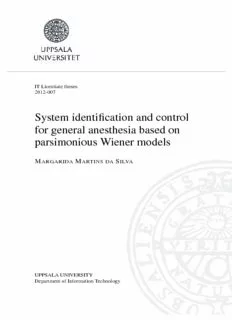
System identification and controlfor general anesthesia based onparsimonious Wiener models PDF
Preview System identification and controlfor general anesthesia based onparsimonious Wiener models
ITLicentiatetheses 2012-007 System identification and control for general anesthesia based on parsimonious Wiener models MARGARIDA MARTINS DA SILVA UPPSALAUNIVERSITY DepartmentofInformationTechnology System identification and control for general anesthesia based on parsimonious Wiener models MargaridaMartinsdaSilva (cid:0)(cid:2)(cid:3)(cid:4)(cid:2)(cid:3)(cid:5)(cid:6)(cid:2)(cid:7)(cid:8)(cid:5)(cid:9)(cid:10)(cid:2)(cid:11)(cid:5)(cid:12)(cid:7)(cid:13)(cid:13)(cid:7)(cid:8)(cid:14) October2012 DivisionofSystemsandControl DepartmentofInformationTechnology UppsalaUniversity Box337 SE-75105 Uppsala Sweden (cid:15)(cid:12)(cid:12)(cid:16)(cid:17)(cid:18)(cid:18)(cid:19)(cid:19)(cid:19)(cid:7)(cid:5)(cid:12)(cid:7)(cid:13)(cid:13)(cid:7)(cid:8)(cid:14)(cid:18) DissertationforthedegreeofLicentiateofPhilosophyinElectricalEngineeringwith SpecializationinAutomaticControl (cid:2)c MargaridaMartinsdaSilva2012 ISSN1404-5117 PrintedbytheDepartmentofInformationTechnology,UppsalaUniversity,Sweden Abstract The effect of anesthetics in the human body is usually described by Wiener models. The high number of patient-dependent parame- ters in the standard models, the poor excitatory pattern of the input signals (administered anesthetics) and the small amount of available input-output data make application of system identification strategies difficult. The idea behind this thesis is that, by reducing the number of pa- rameterstodescribethesystem,improvedresultsmaybeachievedwhen system identification algorithms and control strategies based on those models are designed. The choice of the appropriate number of parame- ters matches the parsimony principle of system identification. The three first papers in this thesis present Wiener models with a reduced number of parameters for the neuromuscular blockade and the depth of anesthesia. Batch and recursive system identification algo- rithms are presented. Taking advantage of the small number of continu- oustimemodelparameters, adaptivecontrollersareproposedinthetwo last papers. The controller structure combines an inversion of the static nonlinearity of the Wiener model with a linear controller for the exactly linearizedsystem,usingtheparameterestimatesobtainedrecursivelyby an extended Kalman filter. The performance of the adaptive nonlinear controllers is tested in a database of realistic patients with good results. 2 Acknowledgments First of all, I would like to thank my supervisors for their support, guidance and inspiration, and for always being available for discussions whenever I needed them. Each one of my supervisors had a special contribution to my life during these years. Teresa Mendon¸ca showed me that medicine can be fun. Torbj¨orn Wigren accepted me as an external student in Uppsala back in 2009 (that made the difference!) and trusted me while working independently. Alexander Medvedev taught me that research has its ”outdoor” side. The administrative staff of the department deserve a thanks for all thehelpandservicetheyprovided, speciallybecauseagreatpartofthat had to be done through emails. Thanks also to all friends and colleagues at the Division of Systems and Control in Uppsala, and all the GALENO group in Porto. Research does not make any sense without team work. I would like to express my gratitude to the Funda¸c˜ao para a Ciˆencia eaTecnologiafortheresearchgrantSFRH/BD/60973/2009,andalsoto the European Research Council (Advanced Grant 247035) for partially funding the work done in this thesis. Funda¸c˜ao Calouste Gulbenkian, Fundac¸˜ao Luso-Americana para o Desenvolvimento and Bernt Ja¨rmarks Foundation also contributed financially to this work, which is gratefully acknowledged. A special thanks go to my parents, Catarina and Reinhard for un- conditional support and love all along the PhD, and for accepting that I cannot be physically present in Portugal, Austria and Sweden at the same time. 3 4 List of Papers This thesis is based on the following papers: I M. M. Silva, T. Wigren, and T. Mendonc¸a. Nonlinear identification of a minimal neuromuscular blockade model in anesthesia. IEEE Transactions on Control Systems Technology, vol. 20, no. 1, pp. 181-188, Jan. 2012. II M. M. Silva, T. Mendonc¸a, and T. Wigren. Online nonlinear iden- tification of the effect of drugs in anaesthesia using a minimal pa- rameterization and BIS measurements. In Proc. American Control Conference (ACC’10), Baltimore, Maryland, pp. 4379-4384, Jun. 30-Jul. 2, 2010. III M. M. Silva. Prediction error identification of minimally parame- terized Wiener models in anesthesia. In Proc. 18th IFAC World Congress, Milan, Italy, pp. 5615-5620, Aug. 28-Sep. 2, 2011. IV M. M. Silva, T. Mendon¸ca, and T. Wigren. Nonlinear adaptive control of the neuromuscular blockade in anesthesia. In Proc. 50th IEEE Conference on Decision and Control and European Control Conference (CDC-ECC’11), Orlando, Florida, pp. 41-46, Dec. 12- 15, 2011. V M. M. Silva, T. Wigren, and T. Mendonc¸a. Exactly linearizing adaptivecontrolofpropofolandremifentanilusingareducedWiener model for the depth of anesthesia, to appear in Proc. 51st IEEE Conference on Decision and Control (CDC’12), Maui, Hawaii, Dec. 10-13, 2012. 5 6
Description: